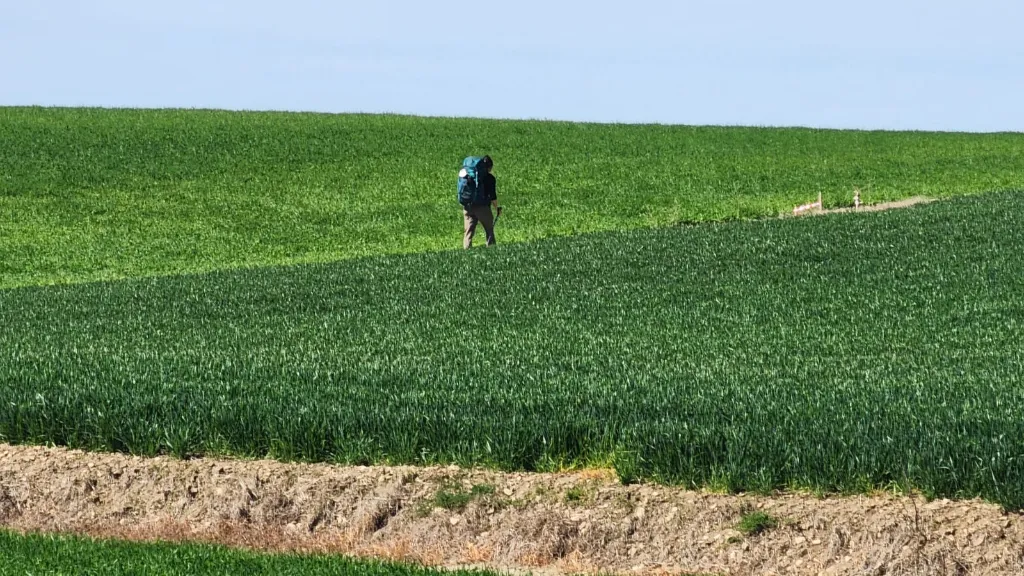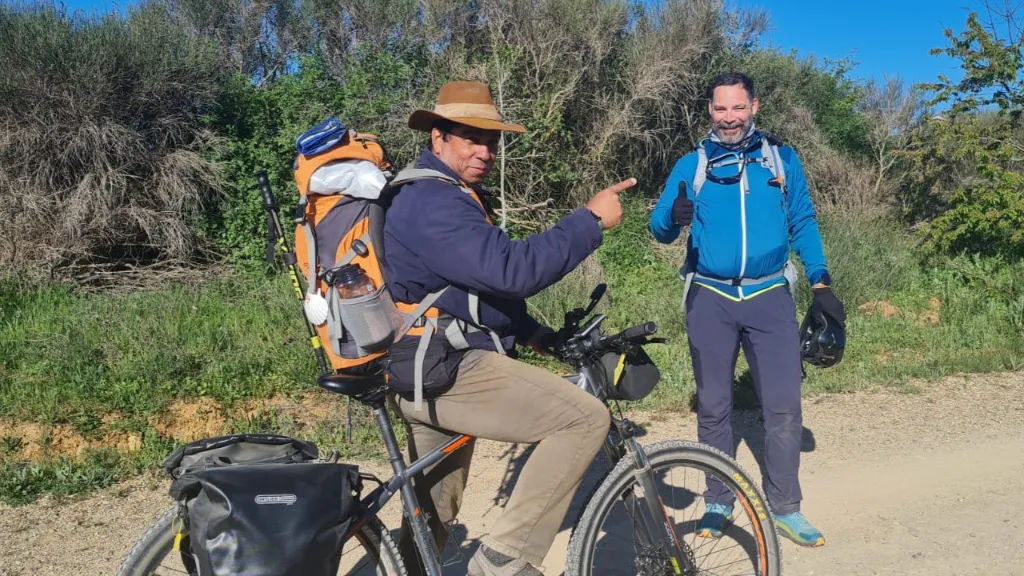The Camino de Santiago is one of the most famous pilgrimages in the world. Throughout its history, various routes leading to Santiago de Compostela have been established, with the French Way being the most popular, covering about 800 km. However, some prefer to start from Portugal or follow a shorter route departing from Spain.
Hélio Araújo, journalist, photographer, creator of the Caminho Podcast, and organizer of the book “Caminho de Santiago: 25 visões peregrinas”, has completed the route five times, following different paths: the French Way, the Portuguese Central Way, the English Way, the Finisterre Way, and the Winter Way, a less popular route. “There are more than ten official routes leading to Santiago de Compostela. In Portugal, for example, there are several pilgrimage itineraries starting in Porto and Lisbon.”
Regardless of the route you choose, Ana Wanke, founder of Ana Wanke Turismo e Aventura, who has been organizing packages and guiding pilgrims since 2005, advises planning at least five months in advance. “It’s important for the pilgrim to prepare physically, emotionally, and financially. When you feel the call of the Camino, stop, breathe, and start organizing — it will work out!”
For those who do not feel safe walking the Camino de Santiago alone, Ana Wanke not only plans the trip but also accompanies pilgrims as a guide. For those who wish to go solo, she provides personalized planning according to the travel goal. Among the services offered by Ana are lodging reservations, daily planning, and four virtual consultancy sessions covering equipment, foot care, daily routine on the Camino (how to act throughout the journey, which apps to use, the hostel routine, and other practical tips), and the history of the Camino de Santiago (its transformation from the Middle Ages to the present).

Where to Stay Along the Camino de Santiago
The Camino de Santiago is very inclusive and offers accommodation for all types of pilgrims:
Public and parish hostels: these are run by churches, volunteers, or associations and are more affordable. However, they do not accept reservations and operate on a first-come, first-served basis.
Private hostels: these are smaller and do accept reservations. “There is a trust relationship between the managers and the pilgrims. It’s not necessary to pay in advance, but I recommend calling a few days before to confirm your stay,” Ana Wanke notes.
Rural houses: located along the route but outside the towns. These are homes organized to host pilgrims. According to Ana, some offer a delicious communal dinner.
There are also options for hostels, guesthouses, and hotels. Due to the high demand for this destination, Ana recommends planning accommodations in advance. “Many people insist on doing the Camino de Santiago without reservations, and from my experience, it’s very stressful. Demand is much higher than supply.”
Hostel Routine on the Camino de Santiago de Compostela
According to Ana, each hostel has its own rules, but generally, they close at 10 PM, lights go out at 10:20 PM, and departure time is 8 AM.
Check out five tips Ana shares in her preparatory classes for pilgrims traveling with her:
- At the hostels, you’ll receive a disposable bedding kit, called sábanas.
- Most hostels restrict entry with boots or shoes on. There is a separate place to leave them, and Ana usually gives clients tags with their names for practical and secure identification.
- It’s common to find washers and dryers at hostels. The cost is around €5.
- Hostels usually have lockers to store valuables like passports, money, or even your backpack. “If there isn’t one, the tip is to put your belongings in a dry bag and take them with you when you shower, for example.”
- If sharing a room with others, Ana advises using earplugs for a peaceful night’s sleep.
Internet and Useful Apps During the Pilgrimage
To stay connected to the internet while walking to Santiago de Compostela, you can opt for an international plan from your carrier or a prepaid SIM card. Ana does not recommend buying the international SIM card in Brazil, due to negative experiences from many clients. For an eSIM, Ana recommends Airalo. “It works very well. You can choose which plan to use, monitor your credits, and top up if needed. The tip is to activate it a day before your trip.”
To check the weather forecast, which can vary during the pilgrimage, Ana recommends using the MeteoBlue app, which provides general daily forecasts for the week of walking, plus information every three hours. Another feature is the 5-day meteogram, which shows a temperature curve with pictograms, cloud layers at different altitudes, and wind forecasts; and the 14-day version, with trends for minimum and maximum temperatures as well as precipitation probability.
Another app frequently used by Ana is OMIO, which makes it easy to buy plane, train, and bus tickets.
Ana also recommends downloading your travel insurance app to locate hospitals or book virtual consultations in case of emergencies.
Cash or Card: What’s Recommended on the Camino de Santiago?
Ana says that most merchants prefer cash payments. Some prepaid cards, according to her, have lower IOF for withdrawing cash, similar to buying the currency in cash. It’s worth checking! In emergencies, Ana recommends international credit cards with a limit.
Services for Pilgrims on the Camino de Santiago
Along the Camino de Santiago, unexpected situations may occur. Here are some support services for pilgrims.
Brazilian Acácio da Paz, who volunteered for seven consecutive years at Camino de Santiago hostels, and his wife Orietta have hosted more than 88,000 pilgrims since 1998. Among the services offered by the couple is lodging at the Refugio Acacio & Orietta, a small welcoming refuge in Viloria de Rioja, sponsored by writer Paulo Coelho and visual artist Christina Oiticica, assistance with bicycle rentals, an emergency hotline, and more — 90% of their clients are Brazilian.

Refugio Acacio e Orietta – Camino de Santiago de Compostela
Bicycle Rentals on the Camino de Santiago
Acácio offers personalized assistance for renting bicycles, whether for pilgrims who want to bike the entire route or just certain segments. This service is available from Burgos to Leon or Burgos to Astorga. For rentals in other locations, Acácio has a collaborator in Ponferrada.
Pedro Lacaz Amaral biked about 150 km of the French Way, which wasn’t part of his plan, and received support from Joelma Buassali, who works with Acácio.
Before starting his pilgrimage, Pedro discovered a plantar wart and had to have it removed. “I set out on the Camino de Santiago with heel pain that prevented me from stepping properly with my left foot. So I put more weight on my right leg. The result: terrible pain in my right knee which, especially on descents, made me walk very slowly. As days passed, my left heel improved, my right knee worsened, and I started putting more weight on my left knee. What was bad got even worse!”
Renting the bike was the solution he found to take care of himself. “My knees recovered well, and I even lent the bike to friends who were going through the same situation.” Among them was psychologist Luiz Henrique, who biked the final 9 km stretch of the mesetas, one of the most challenging parts of the French Way.

Safety: S.O.S. Peregrin@s and Bikegrin@s and ALERTCOPS
Because of his deep knowledge of the Camino de Santiago, Acácio created S.O.S. Peregrin\@s and Bikegrin\@s, a help network organized by the Asociación Paso a Paso de Burgos, providing remote assistance by phone or WhatsApp for people who are lost, had an accident, lost their passport, among other mishaps. Hundreds of calls have been handled in over 22 years of experience on the Camino de Santiago. The service is free at (+34) 679 941 123.
Ana also recommends using the ALERTCOPS app and saving the number 112 in your contacts, both from the Spanish police. “With the app, you can request help, report violence, theft, animal abuse, or harassment, for example. But note that it only works in Spain.”
Luggage Transport
Along the Camino de Santiago, you can have your luggage or part of it transported to specific points. Pilgrim Marianna Sergio, suffering from blisters on her feet, used this service three times during her pilgrimage.
Hélio Araújo also shipped his backpack about five times due to back pain and explains how it works: “You pack your luggage with your details, specifying the pick-up and drop-off points, pay the fee, and leave it at the reception. A van collects and delivers it. There are various companies offering this service.” Hélio notes, however, that municipal and especially parish hostels do not accept luggage deliveries or pick-ups, but nearby restaurants usually allow it.
Companies offering this service include: Jacotrans and NCS Equipajes.
¡Buen camino!
On the Gear Tips blog, you’ll find various articles for pilgrims and about the Camino de Santiago. Check them out and prepare yourself physically, mentally, and with the right gear for a safe and transformative pilgrimage.
To plan your pilgrimage sustainably, read Pedro Lacaz Amaral’s article “The 7 Leave No Trace Principles on the Camino de Santiago”. Awareness of environmental preservation and respect for others should accompany you on all your journeys.
This post is also available in: Português (Portuguese (Brazil)) Español (Spanish)
